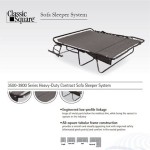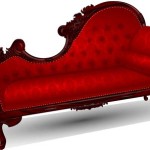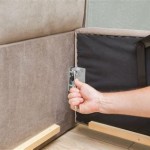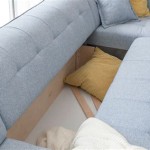Are Sofa Beds Bad For Your Back Pain? A Comprehensive Look
Sofa beds, also known as sleeper sofas, offer a versatile solution for accommodating overnight guests, especially in smaller living spaces. Functioning as both a seating area and a temporary bed, they seem like a practical choice. However, individuals with pre-existing back pain or those prone to back problems often question whether sofa beds are a suitable sleeping option. The answer to this question is complex, depending on several factors relating to sofa bed construction, individual health conditions, and sleeping habits.
The primary concern with sofa beds stems from their inherent design compromises. Unlike conventional mattresses designed solely for sleep, sofa beds are built with a folding mechanism that must fit within the frame of a sofa. This constraint often results in thinner mattresses, less supportive spring systems, and an uneven sleeping surface. Understanding these limitations is crucial for determining if a sofa bed will exacerbate or alleviate back pain.
This article will explore the relationship between sofa beds and back pain, examining the key factors that contribute to discomfort and providing insights into selecting a sofa bed that minimizes potential harm to the spine. We will address mattress types, support systems, and individual considerations to offer a comprehensive overview of this common dilemma.
Mattress Thickness and Support
One of the most significant drawbacks of most sofa beds is the limited thickness of the mattress. Standard mattresses are typically 8-12 inches thick, providing ample cushioning and support for the body's pressure points. In contrast, sofa bed mattresses often range from 4-6 inches, offering considerably less support. This lack of thickness can lead to inadequate spinal alignment, particularly for individuals who sleep on their side or stomach. The reduced cushioning can also cause pressure points to bear more weight, resulting in localized pain and discomfort.
The materials used in a sofa bed mattress also play a crucial role. Inexpensive models often feature thin, low-density foam that quickly compresses under body weight, offering minimal support. Over time, this compression can lead to sagging and unevenness, further compromising spinal alignment. More expensive sofa beds may incorporate memory foam or hybrid mattresses with innerspring coils, providing better support and conforming to the body's contours. However, even these upgraded options may not match the comfort and support of a dedicated mattress.
For individuals with back pain, the lack of adequate support can exacerbate existing conditions. The spine's natural curvature requires proper support to prevent strain and discomfort. When the mattress is too thin and unsupportive, the spine can sag or twist, leading to muscle tension, stiffness, and pain. Furthermore, inadequate support can prevent proper spinal decompression during sleep, hindering the body's natural healing processes.
The edge support of a sofa bed mattress is another important consideration. Many sofa beds lack reinforced edges, causing the mattress to sag or collapse near the perimeter. This lack of edge support can make it difficult to get in and out of bed, especially for individuals with limited mobility or back pain. It can also lead to instability and rolling off the mattress during sleep.
The Impact of the Folding Mechanism
The folding mechanism inherent in sofa bed design presents another set of challenges for spinal health. To accommodate the folding process, the mattress is typically divided into sections, creating seams and hinges that can disrupt the sleeping surface. These seams can be particularly problematic for individuals with sensitive pressure points or those who toss and turn frequently during sleep.
The metal bars and springs that support the mattress within the folding mechanism can also contribute to discomfort. In many sofa beds, these bars are positioned directly beneath the mattress, creating a firm and unforgiving surface. The sleeper may feel these bars through the thin mattress, leading to pressure points and pain. Over time, the constant pressure on these areas can cause inflammation and discomfort.
The folding mechanism can also affect the overall stability of the sleeping surface. Some sofa beds have flimsy or poorly designed mechanisms that wobble or shift during sleep. This instability can disrupt sleep quality and contribute to muscle tension. Furthermore, the mechanism can create unevenness in the mattress surface, leading to spinal misalignment and pain.
The process of converting a sofa into a bed and back again can also be physically demanding, particularly for individuals with pre-existing back pain. Lifting and maneuvering the heavy mattress and folding mechanism can strain the back muscles and exacerbate existing conditions. Choosing a sofa bed with a smooth and easy-to-use folding mechanism can help minimize this risk.
Individual Factors and Mitigation Strategies
While the design of sofa beds can contribute to back pain, individual factors also play a significant role. Body weight, sleeping position, and pre-existing health conditions all influence how a sofa bed affects the spine. Individuals who are overweight or obese may experience greater pressure on the mattress, leading to increased discomfort. Similarly, those who sleep on their stomach may find that the lack of support in a sofa bed exacerbates spinal misalignment.
Pre-existing health conditions, such as arthritis, scoliosis, or herniated discs, can also make individuals more susceptible to back pain from sofa beds. These conditions can compromise spinal stability and make the spine more sensitive to pressure and misalignment. In such cases, consulting with a healthcare professional before using a sofa bed is recommended.
Fortunately, several strategies can mitigate the potential for back pain when using a sofa bed. Adding a mattress topper can significantly improve the comfort and support of the sleeping surface. Memory foam toppers can conform to the body's contours and relieve pressure points, while thicker toppers can provide additional cushioning and support. Choosing a high-quality mattress topper can effectively transform a thin and unsupportive sofa bed mattress into a more comfortable and supportive sleep surface.
Another strategy is to use supportive pillows to promote proper spinal alignment. Placing a pillow between the knees when sleeping on your side can help prevent spinal twisting and reduce pressure on the lower back. Similarly, placing a pillow under the knees when sleeping on your back can help maintain the natural curvature of the spine. Using a contoured neck pillow can also help support the neck and upper back, reducing muscle tension and stiffness.
Choosing a sofa bed with a high-quality mattress and support system is also crucial. Look for models that feature memory foam or hybrid mattresses with innerspring coils. These mattresses tend to offer better support and cushioning than traditional foam mattresses. Additionally, consider models with reinforced edges and a sturdy folding mechanism. Reading online reviews and comparing different models can help you find a sofa bed that meets your specific needs and preferences.
For individuals with severe back pain, using a sofa bed may not be the best option. In such cases, consider alternative sleeping arrangements, such as an air mattress with a built-in frame or a folding cot with a supportive mattress. These options may provide better support and comfort than a traditional sofa bed. Ultimately, the best approach is to prioritize spinal health and choose a sleeping arrangement that minimizes the risk of exacerbating back pain.

Are Sofa Beds Bad For Your Back

Are Sofa Beds Bad For Your Back

Are The Sofa Beds Bad For Your Back Lava Furniture

How To Sit On A Sofa With Lower Back Pain Adjustamatic Beds

How To Find The Best Sofas For A Bad Back

How To Sit On A Sofa Prevent Back Pain Guide Swyft

Are Recliners Bad For Your Back Dos And Don Ts Pain Free Relaxation

9 Best Couches For Posture And Back Health

The Ergonomic Sofa New York Times

How Your Comfy Sofa May Be Causing You Back Pain Center For Spinal Disorders








